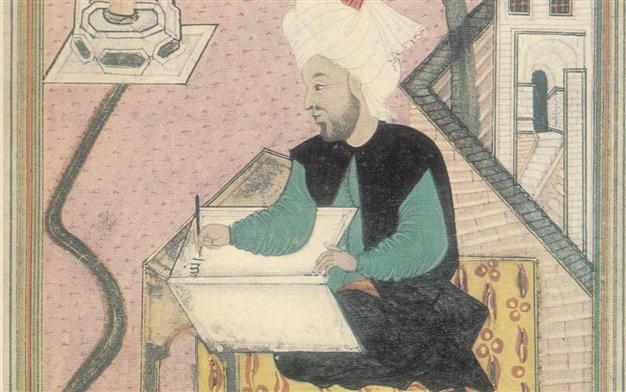Papyrus, parchment and paper in old Istanbul
Niki Gamm

Sheyh Abd al-Muti writes a book, 17th century Ottoman.
The “Sahaflar” (used books) Bazaar, nestled in the shadow of Beyazıt Mosque, has a long and for the most part honorable history that can be traced to Byzantine times. Although some have speculated that today’s location is the same as it was in Byzantine times, others say that it was originally in the Kapalıçarşı. Regardless of which site, it would have been very near New Rome’s Forum Tauri, later the Forum of Theodosius, a center for commercial activities throughout most of the city’s history as New Rome, Constantinople and Istanbul.The Byzantines used this location to sell paper and books that came in two forms - one would have been the book as a roll and the other would be a bound book known as a codex. The roll form originated in Egypt and spread throughout the Roman world. It was used primarily for secular works until approximately the 10th century, while the subjects of the bound book were usually religious. Of the latter the most important ones contained elaborate decorations, either illustrations of the stories being told in the work or as decorative headings of pages or paragraphs.
Since the texts were all handwritten, the beauty of the calligraphy and the quality of the pages and ink were of particular importance. The pages in later centuries were usually of parchment. Classics scholar Nigel G. Wilson in Byzantine Books and Bookmen points out that there must have been factories in the city for the manufacture of parchment, even if there are few references to them.
Parchment was first made in the city of Pergamon either during the third or early second century BC from animal skins to compensate for a scarcity of papyrus usually supplied from Egypt. Wilson also pointed out that at times there were shortages of parchment for writing, citing instances when there were complaints about having to wait until spring when people began eating meat again or having to bring better quality material from elsewhere. In the case of real scarcity, the parchment might be washed, eliminating the writing, and a new book written over it. Paper was introduced into Constantinople from
China around the eighth century AD., possibly brought into the Middle East by Turks. There were paper mills in Baghdad in 794 and somewhat later in Damascus. Although paper began to be used more frequently in Constantinople, especially from the 10th century AD onwards, it was very fragile in comparison with parchment and easily destroyed.
Wilson also suggests that the price of a volume was likely beyond that of an ordinary citizen. Copies of books were usually commissioned since they had to be hand written and illustrated so the very first edition was most likely that written by the author himself unless he dictated it to someone else. Under these circumstances it is doubtful whether there was much of a secondhand market, or even booksellers for that matter, with the exception of religious tracts.
The Ottoman period
The Ottoman book tradition is derived principally from that of Iran. The same materials, approach and subjects can be traced from there, taken up as the Turks traveled through the Near East to Anatolia. Learning was of particular importance in the Muslim world and handwritten manuscripts were the only way to preserve knowledge even though oral traditions existed. Rulers encouraged scholars and poets as a sign that they were supporting culture at the same time that at least some of these writers were immortalizing their names. But manuscripts were handwritten and therefore copies, used or otherwise, were few and far between.
The first of the used book markets was set up in Bursa in the reign of Orhan Gazi (1326-1362). When the capital moved from Bursa to Edirne, the book trade went too. Reportedly many places were given to those who made books and those who were involved in selling them in the courtyard of the large mosques.
Sultan Mehmed II (r. 1451-1481), who was known for his erudition, invited artists and craftsmen in the Muslim world to come and settle in the city following his conquest of Constantinople in 1453. Book sellers set up shop in three places – inside the Fatih Mosque, at Eyüp Sultan, and in the vicinity of Fatih Mosque. The establishment of madrasas (religious schools) at Fatih Mosque is what led to an explosion in the number of book manufacturers and sellers there. A paper mill was established in the city’s Kağıthane district on the Golden Horn and it was used until the reign of Bayezid II (r. 1481-1512) when it was converted into a powder factory. In 1486 a paper mill was opened in Bursa.
After the Kapalıçarşı was built in 1460-61, the book makers were given one of its most desirable sections on Sahaflar Street, across from the Sark Coffeehouse and along where jewelers and carpet dealers are now. It didn’t move to its current location until a destructive earthquake on July 10, 1894. It took four years to rebuild the Kapalıçarşı and several of the groups like the booksellers were moved elsewhere, in this case to their current location, which had been a market for Byzantine booksellers but had been turned over to turban makers and engravers under the Ottomans right after the conquest.
The 17th century travel writer Evliya Çelebi wrote that there were 50 book shops, about 300 employees and many books available. They were considered members of the learned class or ulema and included calligraphers, bookbinders, paper polishers, gilders, paper manufacturers, reed pen knife makers, ink manufacturers and others associated with the art of book making. The shops were more like wooden stalls in which the items being sold would be in back on shelves while the shopkeeper sat in front with customers, drinking coffee or some other beverage and chatting. The most valuable books would be kept in cabinets. At night when the shop closed, curtains were drawn in front of it. Since the Kapalıçarşı was locked and security guards patrolled the streets, there was no need to worry about theft. In fact, there was only one reported theft right up until modern times.
When the decision was finally taken in the 18th century to allow Ottoman Turkish books, the used book trade was revolutionized. Instead of one man painstakingly copying a manuscript by hand, a book only had to be typeset and printed. This put many people out of work, which is one of the other main reasons why the adoption of printing took so long among the Ottomans.
















